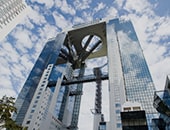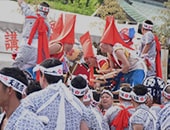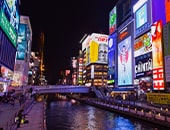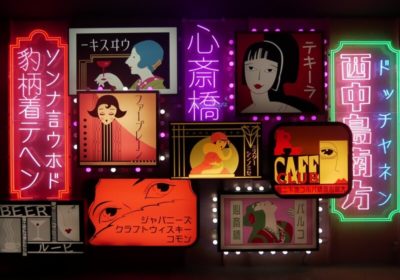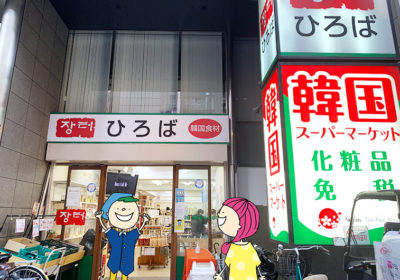夜の徳兵衛以大明神.jpg)

Supporter
Shrines in Osaka’s skyline! Take in the night view at these rooftop shrines!
Did you know you can visit shrines right in the heart of the big busy Osaka downtown area, Umeda? There are two special ones I’d recommend—one on top of Osaka Ekimae Dai-ichi Bldg. (Building No. 1) and the other on Osaka Ekimae Dai-ni Bldg. (No. 2). Normally you would expect a forest and walkway up to a shinto shrine. In this case, there are office buildings to navigate through elevators and escalators. And the view of the torii gate against a backdrop of skyscrapers is so attractive.
If you’re feeling uneasy about something or want to make a prayer for good luck, business prosperity, or family happiness, stop into one of these shrines when you visit the Osaka Station/Umeda area.
[contents]
■Shoichii Fukunaga Inari Daimyojin Shrine—rooftop shrine at Osaka Ekimae Building No. 1 & Showa era vibes

Osaka Ekimae Dai-ichi Bldg. (Building No. 1) has an underground bar area that I used to visit a lot, but I haven’t been there in a while. But while I was visiting a lot, I had heard that there was a shrine on the roof.
When you enter the building, you go to the elevator hall on the 1st floor, and you’ll see signage for the shrine. It reads Shoichii Fukunaga Inari Daimyojin Shrine, (正一位 福永稲荷大明神), and then it says “Good luck, prosperous business, family safety, abundant harvest.” The instructions direct you to take the elevator up to the top floor. It’s open between 10:00am & 4:30pm. Since this is an Inari shrine, a Shinto deity that is sometimes depicted as a fox, you can see illustrations of foxes on the sign as well.

Take the elevator up to the 12th floor rooftop and exit through the north door. You’ll come out onto an outdoor deck, where you’ll see chairs and other equipment that is used for the summer beer garden piled up along one side. Somehow it just feels like Showa era vibes up here. In the northeast corner of the deck, you’ll see a red torii gate peeking out from behind a hedge. It’s just a small spot on the corner of the rooftop.
Face the shrine, there will be very realistic statues of foxes looking back at you. And the fox on the left is holding a scroll in its mouth. There is also a small purification area where you can cleanse your hands. I bowed twice, clapped once, and prayed with all the nearby buildings surrounding me as though they were part of the shrine grounds.
■What does the nickname “Yakezu no Inari” mean?

According to the inscription on a stone monument placed here, this area was a small hill where wild foxes once lived. The shrine history dates to the Nanbokucho period (1336–1392) when a resident named Juro Watanabe created a shrine for the deity Inari to guard his family. During the Edo period (1603–1867), it was called Kitsunezuka, and in the Meiji period (1868–1912), it became an Ohatsu Tenjin shrine. In 1909, when the entire surrounding area was destroyed in the Great Kita Fire, this shrine was the only one left standing. This unusual circumstance earned the shrine the nickname Yakezu Inari or “Unburnt Inari.” It was later damaged in the air raids of 1945. But after the war, Eigoro Nakatani and other locals were able to rebuild the shrine. It was considered a the guardian of nearby Sonezaki Shopping Street at the time. But eventually urban development led to the construction of the Osaka Ekimae Buildings on the site of the shrine. In 1972 the first building was opened and the shrine was moved up to its current location on the rooftop.
It may be far in a corner of a rooftop of a building, but you can sense the strong history of “Unburnt Inari” and its power to bring good luck.
■Open even at night—“Tokubei Daimyojin” in Ekimae Building No. 2

Head over to Osaka Ekimae Dai-ni Bldg (Building No. 2). It’s on the east side of Building No. 1. Once you’re inside, Building No. 2, take the escalator up to the third floor. You might notice the sign for Tokubei Daimyojin (徳兵衛大明神). It also says that special blessing days are on the 8th, 18th, 28th of every month.
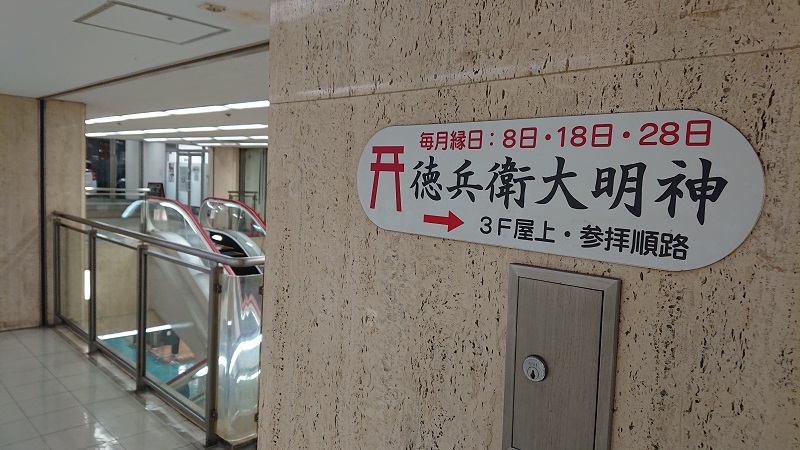
When you reach the third floor, go outside and you’ll come out onto a deck that stretches around the building. It’s actually a parking lot. The lot is for reserved spots only, and the cars enter the lot from a spiral entrance that connects to the ground level. The Tokubei Daimyojin Shrine is located just north of the car entrance.
There is a pair of red lanterns hanging in front of the small shrine building, and a container holding fortune slips (100 yen). The shrine’s urban scenery surrounded by the tall buildings of Umeda buildings mimics the scenery at Fukunaga Inari Daimyojin, because it’s right next door.
Here, there is a stone monument that reads, “Long ago, on the banks of the Shijimi River in Sonezaki, Osaka, there was an old and dilapidated shrine.” The Shijimi River no longer exists, but it once flowed nearby, branching off from Dojima River. And the name for one of the famous bridges that crossed it—Sakurabashi—is still used today, even though the bridge itself is gone.
A deeply religious man named Tokubei worked to repair the shrine and lived here while doing the construction. He prayed often and experienced many miracles, thus the shrine earned a good reputation and became popular. Soon, the shrine came to be called Tokubei Daimyojin. It disappeared a long time ago, but volunteers have since worked to restore the shrine.
Since the shrine is named Tokubei and it’s in Umeda, I thought it might be related to Ohatsu Tokubei, the main character from Chikamatsu Monzaemon’s play The Love Suicides at Sonezaki. But it turns out that is another unrelated Tokubei.

You can visit Tokubei Daimyojin even in the middle of the night because it kept open for access to the parking lot. The atmosphere at night is almost magical, with the backdrop of the city’s buildings at night and the bright red torii gates.
Both shrines are very interesting in their own right and have ancient ties to this land. And even though they were once either abandoned or destroyed, they were rebuilt thanks to the enthusiasm of locals. Despite the changing times and urban development, they both managed to find a new place to exist on top of the city’s buildings. This history reminds me that people’s attachment to certain things and places remains, even if the landscape changes.

Supporter
The contents of this page were current at the time it was posted, but may differ from the present.
Text visible in this map is based on information from Map Tiler and may differ from actual geographical names.


